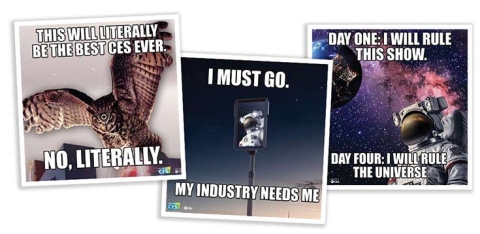Six Ideas to Steal from 2014 Trade Shows

Ours is an industry filled with ingenuity and innovation. Even the shows that have been around for decades find ways to reinvent themselves and bring an exciting and profitable experience to both attendees and exhibitors, making them crave even more next year. Here’re a few ideas tested by shows in 2014 that could bring a new sparkle to your event:
Near Field Communication. Several shows switched this year to Near Field Communication (NFC) technology in attendee badges. In essence, it’s a microchip in the badge encrypted with relevant data about the attendee, such as access to expo, sessions and events. No printing and losing lunch tickets (and drink coupons) anymore. Exhibitors collect leads by scanning badges with their smartphone pre-loaded with a registration app and synched with their database. Since all contact info is digital exhibitors can also instantly send specs and relevant materials.
CES introduced the badges at its 2014 show in collaboration with ITN International. “There’s a bit of a learning curve but people are very excited about it,” said Karen Chupka, senior vice president of events and conferences for Consumer Electronics Association. CES will again use NFT in their badges in 2015.
Licensing Expo 2014 also has a successful experience with NFT. “I heard from a lot of attendees that this was the smoothest entry process they’ve had into a show. It is likely that Advanstar will adopt the same technology for its other shows,” said Chris DeMoulin, president of Licensing & EVP Worldwide Customer Development at Advanstar Communications.
Mobile Engagement Technology. CTIA Super Mobility Week 2014 launched a system that could monitor location of mobile devices on the floor as well as send proximity marketing messages. It collected real-time data from 125 sensors around the floor and created a “heat map” of the busiest booths and presentations displayed in the Big Data Wall in the lobby. At the same time, it allowed exhibitors to send messages to nearby attendees through the official show app and opted-in to receive such notifications. More of proximity messaging is expected at next year’s event.
“You’ll walk into the Samsung booth, and it will ask you questions about what you’d like to see and offer to schedule a meeting and send information to your phone,” said Robert Mesirow, vice president and show director for CTIA. “It makes it a lot more efficient for exhibitors as it automatically does their lead generation and follow-up.”
Shop the Tradeshow. MAGIC Market Week launched its Shop the Floor website as an online product showcase to help extend the life of the show. In 2014, the site became a full ecommerce platform. Buyers can still use it to research products and brands before the show but they also can also place orders throughout the year. “It’s an established brand now,” said Allison Lombardo, vice president of marketing for Advanstar. “And it’s a lot more robust in terms of a shopping experience for the retailer.”
Show Apps All Grown Up. One of the most helpful innovations in show apps has been the introduction of real-time navigation and its integration with other functions. At JCK, attendees could provide information about the desirable products and price ranges and were recommended up to 25 exhibitors that could be a good match. The app would then help schedule appointments and help navigate to the booth during the show.
Along with the GSP routing feature, National Hardware Show app also had a Near Me button that allowed exhibitors to show deals to attendees that had selected their product as category of interest.
Sample Box. Cosmoprof partnered with Glossy Box, a subscription beauty samples service, to create and distribute a limited edition Cosmoprof Box with products launched at the show. “We wanted our exhibitors, especially smaller companies, to get a chance to connect directly with their consumers and also to test the subscription box model that is getting very popular now,” said Daniela Ciocan, marketing director at Cosmoprof North America. “Normally, it takes 30,000 pieces to participate, and it’s a huge investment. Here they only have to contribute 3,000 pieces. We’re hoping it will be a successful partnership with a B-to-C platform.”
Awesome Old School. IT show Interop decided to go the low-tech route to promote attendance at its 2014 event by sending out posters with the history of the show and IT. Their colorful presence on the walls of attendee firms did the trick. “Instead of doing three humongous mail drops, we did one drop to about 100,000 potential registrants,” said Jennifer Jessup, general manager of Interop. “We got better pickup and made more money from those codes than we’d ever done.”
Bonus: Personal Meme Generator. Ok, so this is really a glance into the future, but 2015 CES lets you build a surprisingly accurate and funny personal meme that makes it hard to resist sharing on social media. Even if you’re not going, it might be worth it just as inspiration for next year.


Add new comment